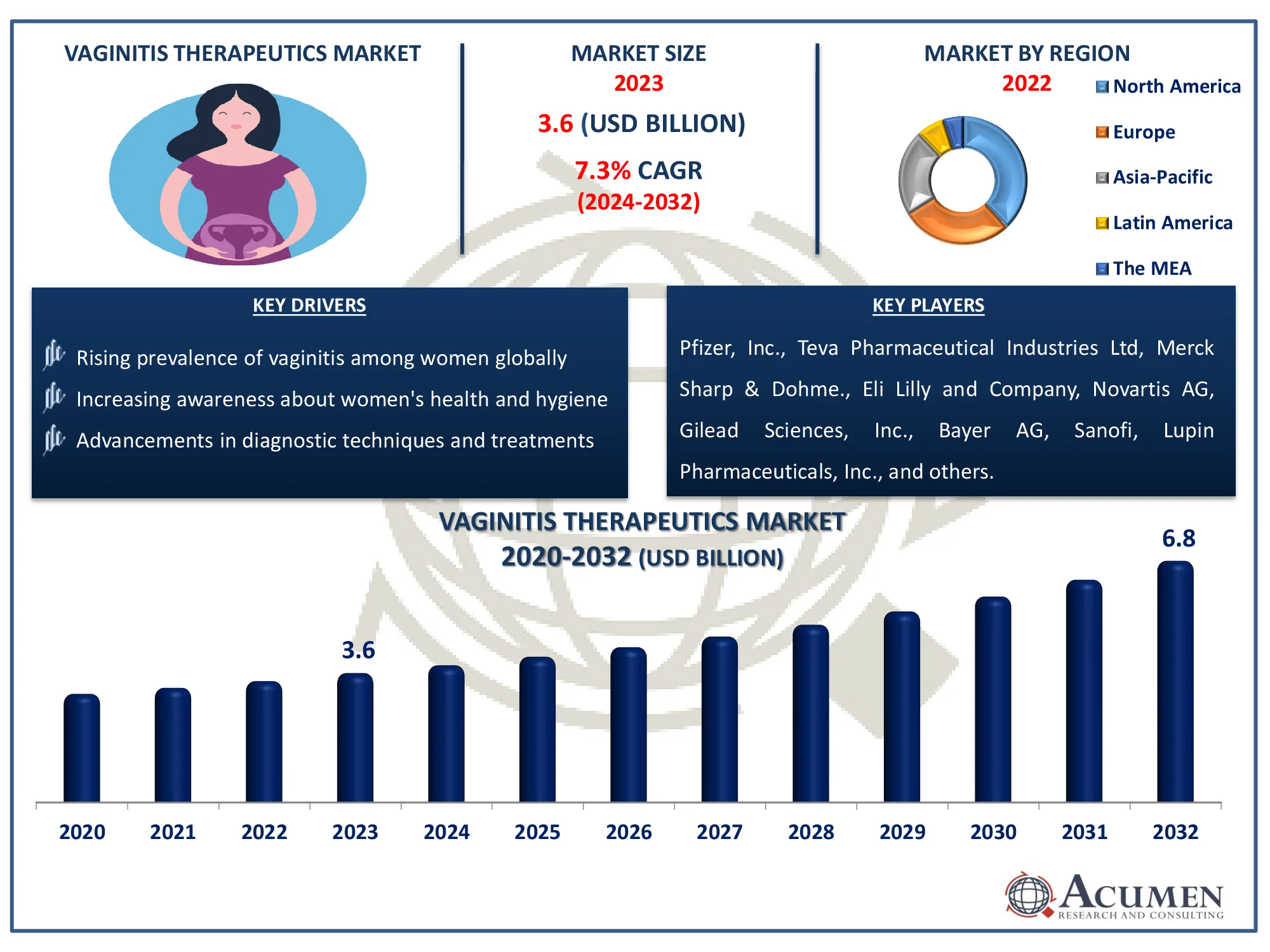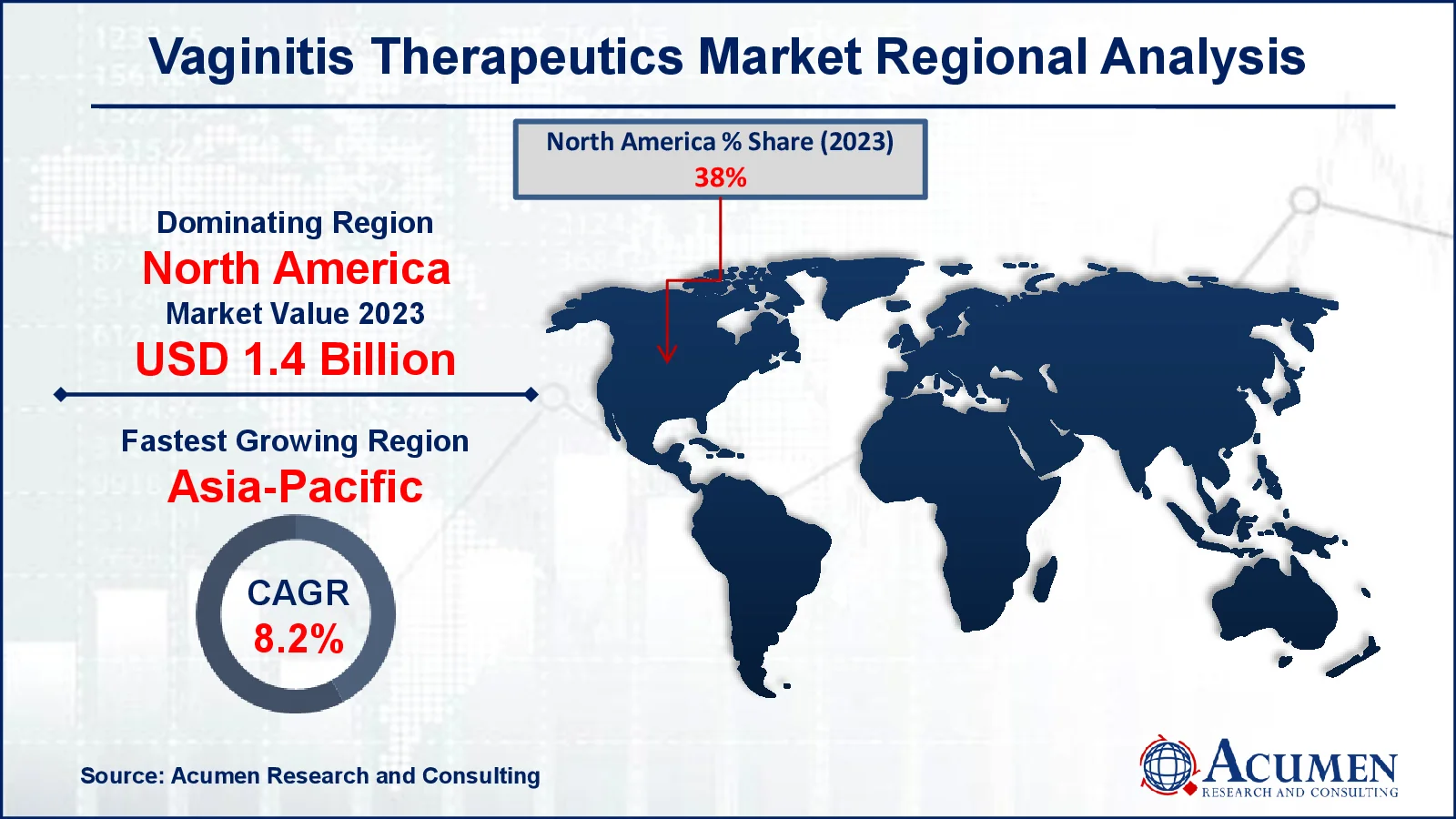April 2021
The Vaginitis Therapeutics Market is expected to grow from USD 3.6 billion in 2023 to USD 6.8 billion by 2032, driven by increasing demand for effective treatments. Explore market dynamics and growth projections.
The Global Vaginitis Therapeutics Market Size accounted for USD 3.6 Billion in 2023 and is estimated to achieve a market size of USD 6.8 Billion by 2032 growing at a CAGR of 7.3% from 2024 to 2032.
Vaginitis Therapeutics Market Highlights

Vaginitis therapeutics refers to the medical treatments and interventions used to address vaginitis, an inflammation of the vagina often resulting in discharge, itching, and pain. Vaginitis can be caused by infections, such as bacterial vaginosis, yeast infections, or trichomoniasis, as well as irritants like chemicals or allergens. Therapeutics in this context includes antifungal medications, antibiotics, and hormonal treatments tailored to the specific cause of the condition. For instance, bacterial vaginosis is typically treated with antibiotics like metronidazole, while antifungals like fluconazole are used for yeast infections. Hormonal imbalances causing vaginitis might be managed with estrogen therapy. The goal of these treatments is to alleviate symptoms, eliminate infection, and restore the natural balance of vaginal flora.
Global Vaginitis Therapeutics Market Dynamics
Market Drivers
Market Restraints
Market Opportunities
Vaginitis Therapeutics Market Report Coverage
| Market | Vaginitis Therapeutics Market |
| Vaginitis Therapeutics Market Size 2022 |
USD 3.6 Billion |
| Vaginitis Therapeutics Market Forecast 2032 | USD 6.8 Billion |
| Vaginitis Therapeutics Market CAGR During 2023 - 2032 | 7.3% |
| Vaginitis Therapeutics Market Analysis Period | 2020 - 2032 |
| Vaginitis Therapeutics Market Base Year |
2022 |
| Vaginitis Therapeutics Market Forecast Data | 2023 - 2032 |
| Segments Covered | By Drug Class, By Mode, By Disease Type, By Distribution Channel, And By Geography |
| Regional Scope | North America, Europe, Asia Pacific, Latin America, and Middle East & Africa |
| Key Companies Profiled | Pfizer, Inc., Teva Pharmaceutical Industries Ltd, Merck Sharp & Dohme., Eli Lilly and Company, Novartis AG, Gilead Sciences, Inc., Bayer AG, Sanofi, Lupin Pharmaceuticals, Inc., Mission Pharmacal Company, and Johnson & Johnson. |
| Report Coverage |
Market Trends, Drivers, Restraints, Competitive Analysis, Player Profiling, Covid-19 Analysis, Regulation Analysis |
Vaginitis Therapeutics Market Insights
The rising prevalence of vaginitis among women globally is significantly driving the growth of the vaginitis therapeutics market. For instance, according to National Institute of Health, bacterial vaginitis prevalence varies across different countries and population groups. However, a recent systematic review and meta-analysis found that the global prevalence of BV among women of reproductive age ranges from 23% to 29%. Increased awareness about vaginal health, coupled with advancements in diagnostic techniques, is leading to earlier and more accurate diagnoses. This, in turn, boosts the demand for effective treatment options. Additionally, the development of new and improved therapeutics is further propelling market expansion.
Limited access to healthcare in developing regions hinders the growth of the vaginitis therapeutics market. For instance, according to the Rural Health Information Hub, barriers to healthcare access in rural areas include distance and transportation challenges, workforce shortages, lack of health insurance coverage, inadequate broadband access, poor health literacy, and issues related to social stigma and privacy. Many individuals in these areas face barriers such as lack of medical facilities, financial constraints, and limited awareness, leading to untreated or improperly managed conditions. This results in lower demand for therapeutic products and hampers market expansion. Addressing these challenges is crucial for improving healthcare outcomes and market growth in these regions.
The development of personalized medicine and targeted therapies presents a significant opportunity for the vaginitis therapeutics market. For instance, in 2023, PMC (Personalized Medicine Coalition) will keep working on how to regulate, fund, and incorporate new personalized medical treatments and diagnostics into health systems. These advanced approaches enable treatments to be tailored to the specific genetic and microbial profiles of individual patients, enhancing efficacy and minimizing side effects. By leveraging genomic data and precision diagnostics, healthcare providers can identify the most effective therapeutic agents for each case of vaginitis. This personalized approach not only improves patient outcomes but also drives innovation in therapeutic research and development, ultimately expanding the market for targeted vaginitis treatments.
Vaginitis Therapeutics Market Segmentation
The worldwide market for vaginitis therapeutics is split based on drug class, mode, disease type, distribution channel, and geography.
Vaginitis Therapeutic Market By Drug Class
The vaginitis therapeutics market is dominated by the anti-bacterial drug class due to the high prevalence of bacterial vaginosis, a common vaginal infection. These drugs are highly effective in targeting the bacterial causes of the condition, leading to significant demand. Their proven efficacy, widespread availability, and established usage protocols make them the preferred choice among healthcare providers. Consequently, driving growth and development within this segment.
Vaginitis Therapeutic Market By Mode
According to the vaginitis therapeutics industry analysis, prescription (Rx) mode dominates due to the need for accurate diagnosis and targeted treatment by healthcare professionals. Prescription medications offer tailored solutions for various types of vaginitis, ensuring efficacy and safety. This dominance is also supported by the preference for physician consultations, which help in managing symptoms and preventing complications. Additionally, regulatory approvals and clinical guidelines often prioritize prescription treatments over over-the-counter options.
Vaginitis Therapeutic Market By Disease Type
According to the vaginitis therapeutics market forecast, bacterial vaginosis (BV) dominates due to its higher prevalence compared to candidiasis and trichomoniasis. BV is caused by an imbalance in the vaginal microbiota, which is common among women of reproductive age. Its symptoms often overlap with other conditions, leading to increased diagnosis and treatment. Additionally, the growing awareness and improved diagnostic methods for BV contribute to its market prominence. . For instance, in January 2024, Heranova received $13.5 Million in funding to support its development of new, less painful methods for diagnosing and treating endometriosis and bacterial vaginosis.
Vaginitis Therapeutic Market By Distribution Channel
According to the vaginitis therapeutics industry forecast, retail pharmacies shows notable growth due to their widespread accessibility and consumer familiarity. They offer immediate, over-the-counter solutions and prescriptions, making them a convenient choice for patients. While online pharmacies are growing, the physical presence and instant availability of retail pharmacies give them a significant edge. Hospital pharmacies and direct sales play smaller roles, serving specific needs or niche markets.
Vaginitis Therapeutics Market Regional Outlook
North America
Europe
Asia-Pacific
Latin America
The Middle East & Africa

Vaginitis Therapeutics Market Regional Analysis
For several reasons, the North America leads the vaginitis therapeutics market due to its advanced healthcare infrastructure, high prevalence of vaginitis conditions, and significant investment in research and development. The region benefits from a well-established network of pharmaceutical companies and a robust regulatory environment, fostering innovation and the availability of effective treatments. For instance, in July 2023, Daré Bioscience, Inc., a leading company in women’s health innovation, highlighted its commitment to the commercial launch of XACIATO (clindamycin phosphate) vaginal gel, 2%, in collaboration with Organon. Additionally, Organon agreed to pay Daré $1.0 Million in July 2023. Overall, these factors combine to establish North America as a dominant force in the market for vaginitis therapeutics.
The Asia-Pacific region is the fastest-growing market for vaginitis therapeutics due to rising awareness about women's health, increasing healthcare infrastructure, and a growing patient population. For instance, according to Press Information Bureau (PIB), as of July 31, 2023, over 14.35 crore teleconsultations have been conducted through the eSanjeevani portal. Additionally, screening for breast cancer, oral cancer, and cervical cancer is being carried out at AB-HWCs. Moreover, economic development and improving access to medical treatments are driving demand for advanced therapeutic options.
Vaginitis Therapeutics Market Players
Some of the top vaginitis therapeutics companies offered in our report includes Pfizer, Inc., Teva Pharmaceutical Industries Ltd, Merck Sharp & Dohme., Eli Lilly and Company, Novartis AG, Gilead Sciences, Inc., Bayer AG, Sanofi, Lupin Pharmaceuticals, Inc., Mission Pharmacal Company, and Johnson & Johnson.
Looking for discounts, bulk pricing, or custom solutions? Contact us today at sales@acumenresearchandconsulting.com
April 2021
April 2025
March 2023
August 2023